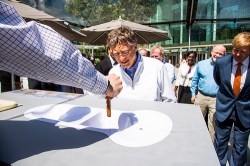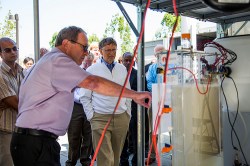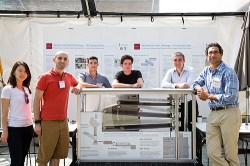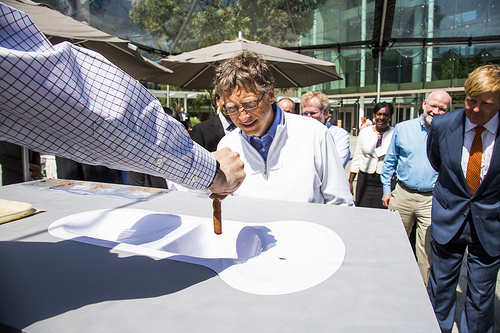
Bill Gates watches a researcher from the University of Toronto feed fake poo into a NASA-worthy, next-gen crapper. (Photo by Gates Foundation.)
The first thing that strikes you about the “Reinventing the Toilet” fair at the Bill and Melinda Gates Foundation in Seattle this week is that the scene looks more like a wing of the Air and Space Museum than the bathroom section at your local Home Despot. Toilets here incorporate solar panels and collectors, windmills, and gizmos that look like jet engines. They generally look like something you’d get in trouble for taking a shit in.
The second thing that strikes you is that no one here is talking about taking shits. (George Carlin would no doubt be relieved.) No crap, no No. 2, no dookie: It’s all “feces” and “urine.” Even the toilets get referred to as “user interfaces.”
We’ll forgive the gathered scientists and engineers for their lack of scatological slanguage (or just candor) given the gravity of their undertaking. The Gates Foundation has committed more than $3 million in prize and R&D money to redo the loo for the estimated 2.5 billion people worldwide who have probably never heard the term “sewer trout” because they don’t even have a sewer.

Gates gets the runs-down on the winning throne from a Cal Tech researcher. (Photo by Gates Foundation.)
Andrew Whitesell with Beaumont Design lays the problem bare. Whitesell’s company has collaborated with several other firms to create a system they call the Fecal Sludge Omni Digester (finally! a sense of humor!) that sucks up the doo-doo lagoons that fester in the crude pit latrines and septic tanks common in the developing world. Many of these are inaccessible to the vacuum trucks that could clean them out — and the trucks do a crappy job, anyway. So residents have to shovel the scheisse by hand.
“It’s dangerous work,” Whitesell says. “If they cut themselves, it’s a death sentence: There’s cholera, hepatitis, flesh-eating bacteria — just about everything you can imagine.”
Many families send their kids into the pit to do the duty. Remember the “shit dive” scene from Slumdog Millionaire?
All this sordid snorkeling and lack of general sanitation is serious shintos. As we’ve reported before, food and water that come into contact with caca lead to 2.5 billion cases of diarrhea in children each year, and 1.5 million kids die as a result. People with diseases connected to poor sanitation fill half of the hospital beds in the developing world. The Gates Foundation hopes to stem the flow with Toilet 2.0.
To be eligible for the prize money, each toilet had to meet the following criteria:
- It operates “off the grid” without connections to water, sewer, or electrical lines.
- It removes pathogens from human waste while recovering valuable resources like energy and fertilizer.
- It costs less than 5 cents per user, per day for capital and operation costs.
- It is a truly aspirational, next-generation product that even wealthy nations will want.

Researchers from Loughborough University with the No. 2 loo. (Photo by Gates Foundation.)
Eight teams took part in the competition, and Mr. Gates himself was on hand Tuesday to give out the awards. Here are the winners (our titles, not the Gates’):
The Big Shit: The California Institute of Technology scored $100,000 for its solar-powered toilet that actually generates electricity from your crap. Team member Kangwoo Cho, a grad student in environmental science and engineering, explains that the gizmo disinfects the diaper gravy using an electro-chemical reaction, squeezing out hydrogen that can be used to cook, heat your house, or just light a massive blue dart. Other byproducts include water clean enough to be used for the next flush.
No. 2: The U.K.’s Loughborough University landed $60,000 for a toilet that works “like a pressure cooker,” roasting your steamers at 200 degrees C, according to Eric Danso-Boateng, a team member from Ghana. The end products include stove-ready methane gas, clean water, and “carbonized solids” that look — and, he insists, smell — like coffee grounds.
Turd Place: The University of Toronto scored $40,000 for an elaborate belt-driven contraption that de-juices your mukky, mixes it with sand, and bakes it for a couple of hours, producing sanitized solids and water clean enough to wash your hands with. (Project collaborator Rory Hadden admits that the guys in the lab actually call it “the poop.” Bonus points for Rory.)

The creators of the “Toronto toilet” show off their john. (Photo by Gates Foundation.)
Other notables include a sky-blue, floor-to-ceiling “user interface” created by the Swiss Federal Institute of Aquatic Science and Technology that won a $40,000 special-mention prize, something called the Power Earth Auger that certainly sounds impressive (though I didn’t have time to figure out how it works), and a “movable, 5-toilet array” that looks like you could land it on the moon.
So next time you find yourself contentedly reading Grist on your iPad as you drop the kids off at the pool, consider yourself fortunate. And be glad for Bill and Melinda, who don’t take bull turkey jive from no one.
Before long, we’ll have 9 billion humans on this rock, each of them pumping out the fudge — and that, my friends, is a shitload of shiznak.
See also: The Gates Foundation just bought 50 gallons of fake poo



